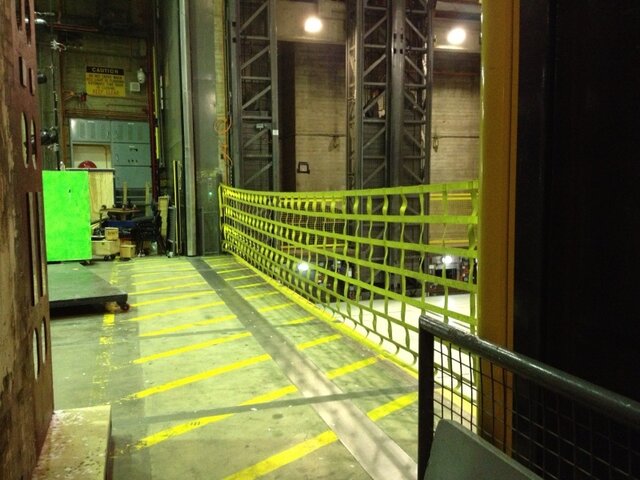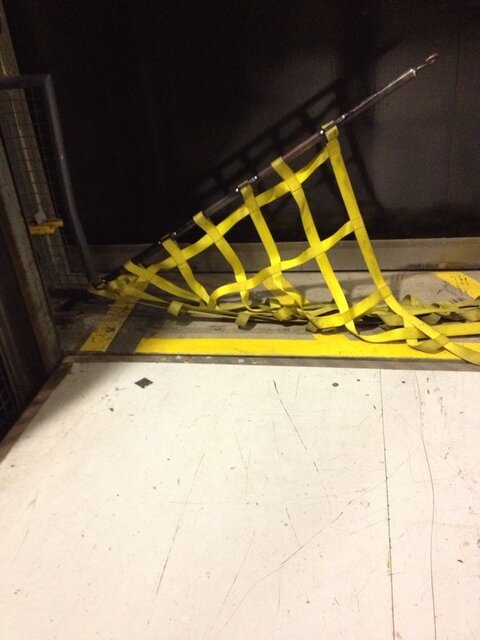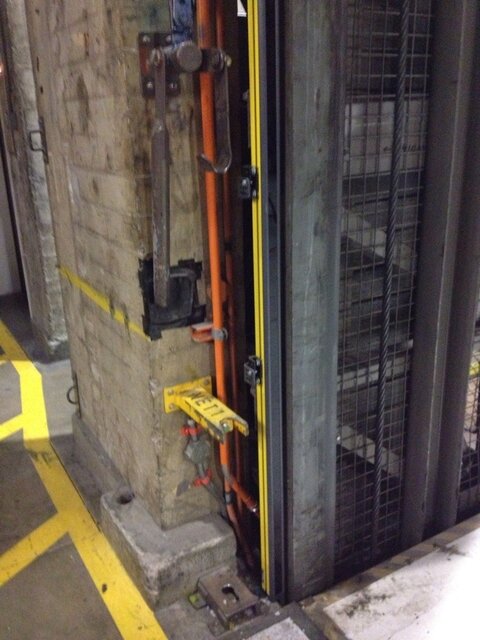Hello from the staging dept! I think I helped you guys move the timp's last week

Some extra info regarding the SOH setup:
The photos posted are from the
loading dock level. In the first photo, the equalisers are down, waiting for the lift platforms (there are 2) to be lowered from
stage level - they won't move if the nets aren't locked. Once the lift platforms are locked off at
stage level and the equalisers have been raised (as in photos 2 and 3), all the nets can be opened - we frequently use the equalisers as a storage or
build area when work is happening onstage and we need extra dock space. If any of the gates are open, the lifts and equalisers will not move unless overridden manually via a locked control box. There are also several access gates on either side of the equalisers which also need to be locked in order for the lifts to move - they are all sliding gates with a drop-down locking bar, and you can see two of them in the background of the first photo.
The second photo shows how we often leave the net if the lifts are due to be moved shortly, but we still want to allow quick access across the equalisers - the net is generally stowed by being pushed across to the wall and left
bundled on the floor with the pole hanging on a hook on the wall, but in some cases we'll just leave it lowered like you see in the picture. The black wall you see is actually our sound/fire door, which is visible in the first photo on the right in it's open position, and it runs along the metal
track in the middle of the yellow zone. This does not need to be closed in order for the lifts to run, but is usually closed during performances.
The third photo shows the actual locking mechanism: the pole fits into the hole at the
base, the hook goes around the pole, and the lever lifts up to lock it into place. The blue metal
tab above the hook and lever is a little locking bar for the lever - we had them put in on all the levers after they started to unlock themselves occasionally (they're old, and the mechanism is starting to give out). It takes quite a
bit of force to hook the pole in and raise the lever and the way it is set up now, there is no way for it to be accidentally unlocked.
At
stage level, the net setup is exactly the same, and we have a smaller secondary net that can be placed between the two platforms if only one needs to be lowered (IE: on shows which
build onto the
downstage lift, or use the upstage lift as an
element of the show). An indicator on the control panel at dock
level shows if the nets at
stage and dock
level are open or closed, and all lift runs are called by a
stage supervisor via intercom or
headset. There is currently no video
monitor allowing the lift operator at dock
level to see what is happening onstage or on the lift, but we're trying to convince management to install one, as it would greatly help the operator tell if something is going wrong with the load (especially considering that the upstage lift has a tendency to run about 20mm out of synch with it's partner - we have to be very aware of load shifting). The lift platforms themselves have no barriers - there is a "
safety zone" about 1m in from the
edge where we are supposed to stand when riding the lift, but that area is usually filled with set, so everyone just stands as far back from the edges as is
practical and never stands on anything with wheels. Last year they installed sensors all the way up the walls of the lift
track that would cause the lifts to stop if anything went past them - unfortunately, they proved to be too sensitive, and caused some really scary e-stops that were more dangerous than anything falling off, and were quickly deactivated.
If you want to see a video of the whole
system in action, check out this timelapse of a matinee-to-evening
changeover from a couple of years back - it shows the lifts, gates, and fire door in use:





